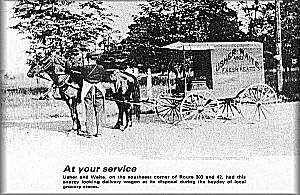|
Commerce in Brunswick
Sun Newspapers, Thursday, August 16, 1984
Brunswick industry dates back to 1820
Humble Start
Commerce in Brunswick grew from
basic pioneer industries.
Business enterprise in Brunswick, a township first surveyed in 1796 by Abraham and John Freese, began along traditionally humble pioneer lines. Barter was the first form of business when Brunswick was actually settled in 1815.
John Hulet arrived with other settlers in the summer of 1815 and one history book tells us "John Hulet and his multitude of boys were excellent mechanics, able to turn their hands to one process or another, so their skills were in great demand."
It was the order of the day for ladies to trade goods for cotton dress material - the local ladies weaved linen to linsey-woolsey. Millie Tillotson, daughter of the family which settled at what is now Mapleside Farms, shocked the area when she appeared in a pink cotton calico dress because most of the days' apparel was of drab, dark colors. She had traded her drab woven stuff for the material and then paid the local milliner, Nancy Stevens, to make the dress and matching hat.
When Archibald Mills opened the first "real" store in 1824, it was with $1500 worth of goods of a general assortment. And saw mills began to flourish because of the influx of families. Nathan Clark operated a saw mill. One built by a man named Entiton was built on Plum Creek and was water powered. Isaac and Fletcher Hulet had a saw mill on a dam near the area which is now Brunswick Lake.
Bennett and Stow had the first steam-operated mill about two miles north of the center. The best one, according to historians, was built by Hiram Brooks in Bennett's Corners and operated for many years.
In 1838 Willis Peck built a tannery about two miles north of the center with five vates in which he dressed skins of all kinds. Solomon Deming built a large treadmill a mile west of the center but the product was inferior flour or meal. Most farmers waited for dry weather to travel to a better mill in Middleburg. Nathan Clark opened a sort of cabinet shop in the village and made coffins and other useful items, while an unnamed businessman manufactured Windsor and other chairs for several years.
With the horse predominant, blacksmith shops sprang up all over. One was operated by Gene Miner at the site of what is now L&B Equipment and Midas Muffler. South of there, Earnest Wilkey owned a shop and Jack Smith was Beebetown's blacksmith. Perry Loomis operated a shop at Bennett's Corners and Dwight Smith handled business down near Substation Road.
In 1901 the Cleveland Southwestern Interurban came through Brunswick and was operated for 30 years bringing many goods and services to the community. John Randall, with horse and wagon, transported goods from the Interurban to the post office and "new fangled" baker's bread came in the station each morning in wicker cases and was sold at the local stores.
The first telephone office started in 1899 with the first toll line between Cleveland and Brunswick. Local lines were installed two years later. The line went from Brunswick to the Valley City B&O depot so residents could find out if the goods had been delivered by freight. By 1918 telephone manager (installer, repairman, etc.) Dennis M. Johnson had over 100 customers.
For many years, the Aylard Brothers had a store in a wooden building at the center. In about 1909 they bought the bricks from the Congregationalists when their church was torn down and built the brick building which stands in the southwest corner of Rt. 303 and 42. Finally, Usher and Waite bought the store and through the years there have been various owners. It is now a multiple-use building with Society National Bank and ROM Travel the major tenants.

In 1911 the old wooden building on the opposite corner known as the IOOF hall was torn down and replaced by a two-story brick building which was torn down this month to make way for the widening of the intersection. Perkins and Ridiker sold their general store at Bennett's Corners and moved into the first floor of the building while the IOOF lodge kept the upstairs rooms. Many Brunswickites remember more recently that it was a store run by Carl Zimmerman and then sold to Bishop Realtors.
In about 1915 Farnum Gibbs built a business and apartment building near the electric substation with feed and implements on the first floor and living quarters upstairs.
In 1924, Corte Carlton bought the Arthur Mellert Garage at 1420 Pearl Road, and with brother Blake, opened a Ford agency and garage. (In 1930, a Model A, two door sedan sold for $535.) In 1956 the showroom was built at 1911 Pearl Road and is now occupied by Metro Harley-Davidson. Later the Ford Agency moved to 1633 Pearl Road which is now the Brunswick Datsun Dealer, and in 1976, Frank White Ford built a new agency at Rt. 303 and I-71 which is now Midwest Ford. (transcriber's note: in August of 2001, it is now Legacy Ford)
A black, horsedrawn hearse was the symbol of George Pitkin, the local funeral director. Services were held in church or home as there was no funeral parlor until the Carlson family began its business here in the early 1960s.
Barbershops (no beauty parlors, ladies) were strictly for men, and Bernie Hunt had a shop at the Aylard block while George Sharvat had one at Bennett's Corners. Frank Case had an ice cream parlor in the front room of his home in the site now occupied by Walt's Pizza. The first "real" restaurant was started in the 1930s by Irene and Tom Hogue. "The Village Inn" was just south of the center. (transcriber's note: see Word document "Brunswick Industry" - a lot of this is repetition...)
In 1931 the Chamber of Commerce was organized. Ralph Strong, who owned Longview Farms, was a charter member which also counted Elmer Eyssen, Earnest Waite, Morris Perkins, John Kilgore, Corte Carlton, Dennis Johnson and Martin Lutz as members.
Today there are literally hundreds of businesses in Brunswick. Some are located in buildings along Rt. 42 and 303 or in the Industrial parks. Some are nestled in homes. The Chamber of Commerce has stuck it out through good times and bad and is once more coming into its own as a strong voice in the community.
In 1875 the Chamber hired its first manager, and this year Jan Moll took over that position.
The Chamber began sponsorship of Old Fashioned Days with a modest start in 1979 and the event grows bigger and better each year as more and more people get involved.
|



